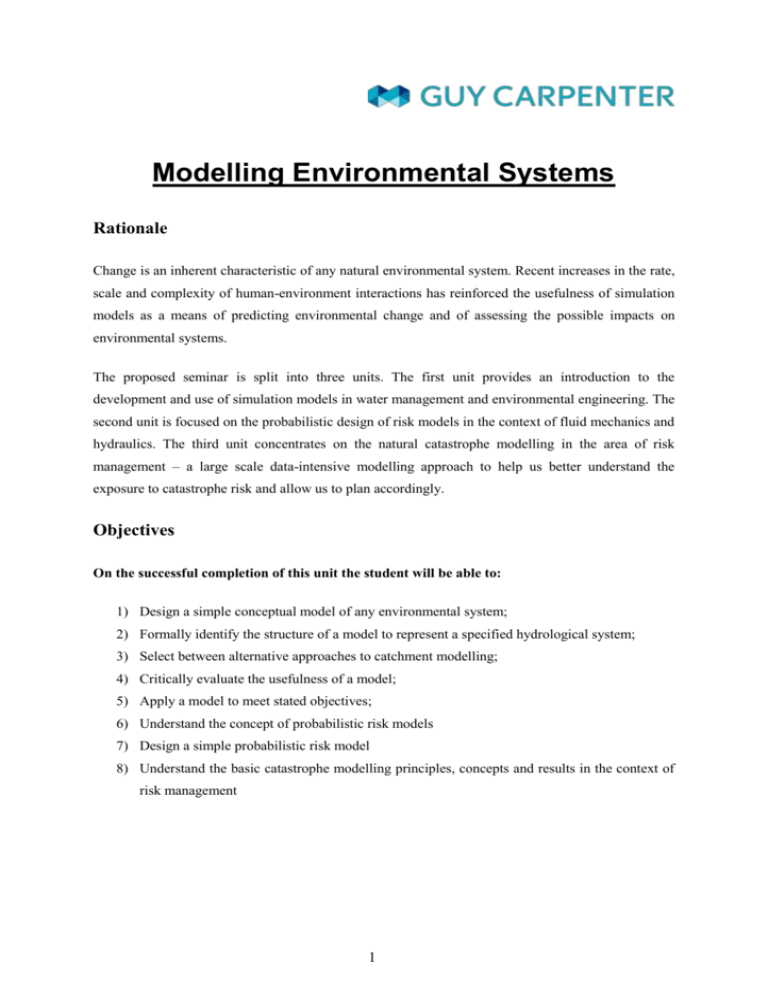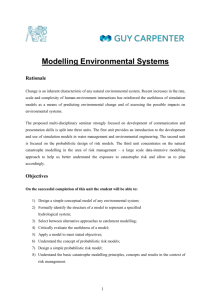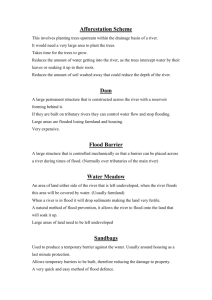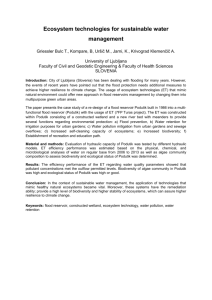Water Balance Problems
advertisement

Modelling Environmental Systems Rationale Change is an inherent characteristic of any natural environmental system. Recent increases in the rate, scale and complexity of human-environment interactions has reinforced the usefulness of simulation models as a means of predicting environmental change and of assessing the possible impacts on environmental systems. The proposed seminar is split into three units. The first unit provides an introduction to the development and use of simulation models in water management and environmental engineering. The second unit is focused on the probabilistic design of risk models in the context of fluid mechanics and hydraulics. The third unit concentrates on the natural catastrophe modelling in the area of risk management – a large scale data-intensive modelling approach to help us better understand the exposure to catastrophe risk and allow us to plan accordingly. Objectives On the successful completion of this unit the student will be able to: 1) Design a simple conceptual model of any environmental system; 2) Formally identify the structure of a model to represent a specified hydrological system; 3) Select between alternative approaches to catchment modelling; 4) Critically evaluate the usefulness of a model; 5) Apply a model to meet stated objectives; 6) Understand the concept of probabilistic risk models 7) Design a simple probabilistic risk model 8) Understand the basic catastrophe modelling principles, concepts and results in the context of risk management 1 Syllabus Unit A: Modelling Environmental Systems – Introduction (Sponsors: Miroslav Hrncir, Alice Hladikova) 1) The role of modelling; objectives and concepts, types of models, model components 2) Modelling procedures; problem definition, boundary conditions, data requirements, calibration and validation 3) Sensitivity analysis, parameterization, calibration, validation and evaluation 4) Practical 1: Design of a simple conceptual model – See Appendix 1 Unit B: Probabilistic design of risk models in the context of fluid mechanics and hydraulics (Sponsor: Marc Melsen) 5) Definition of risk, difference between local and global risk models 6) Response surface methodology, how to calculate return periods? 7) Practical 2: Design of a probabilistic model for a dam breach 8) Practical 3: Design of a probabilistic model for a dike overtopping Unit C: Natural Catastrophe Modelling in the context of risk management (Sponsors: Vladimir Binovec, Alice Hladikova) 9) Natural catastrophes 10) Basic catastrophe modelling principles 11) Catastrophe modelling modular concept and results 12) Practical 4: Flood event case study – See Appendix 2 2 Bachelor projects The seminar gives an opportunity for a study of a wide range of issues related to the modelling of environmental systems. Below are suggested topics for a bachelor thesis, but these are neither exclusive nor exhaustive. Students are encouraged to submit their project proposals from the following areas: 1) Source of flood risk Suggested topics include; flood forecasting (meteorological aspects), flood warning, land management and runoff control (rural/urban), sustainable urban drainage systems 2) Flood pathways Suggested topics include; environmentally sensitive engineering, washlands & biodiversity, floods and river water quality, geomorphology & aquatic habitats, emergency responses, operation and management of flood defence structures 3) Flood receptors Suggested topics include; flood risk mapping, land use planning & flood risk, flood damage (urban, rural areas), economic evaluation of flood damage, flood warning response, flood insurance, flood proofing and damage avoidance, public awareness Proposed bachelor projects Project 1: Flood risk mapping in the EU region – methods, availability and use (Sponsors: Miroslav Hrncir, Vladimir Binovec) Scope: To support the transition from traditional flood defence strategies to a flood risk management approach at the catchment scale in Europe, EU has adopted a new Directive (2007/60/EC) at the end of 2007. One of the major tasks which member states must carry out in order to comply with this Directive is to map flood hazards and risks in their territory, which will form the basis of future flood risk management plans. The thesis should provide an overview of existing flood mapping practices in 29 countries in Europe and show what maps are already available and how such maps are used. 3 Project 2: Large scale flood correlation based on catchment similarity indices (Sponsors: Marc Melsen, Miroslav Hrncir) Scope: The objective of this high level large-scale hydrological assessment is to split the European region into quasi-homogeneous catchment areas based on the physical characteristics and urbanization criteria driving the flood generation processes. The considered physical characteristics may include geography, morphology, land use, climate, urbanization and hydrography of which the most important flood descriptors seem to be size, wetness and soil properties. 4 Appendix 1 Practical 1: Design of a simple conceptual model Five problems are presented below which can all be solved using a water balance simulation model with minimal input data. For each problem, you may assume that daily rainfall data are available from a nearby station, but other data must be gathered from published sources or limited field work. Time will not permit more than one day's field work in the area. For one of the problems: Develop a conceptual model of the problem showing ‘stores’ of water, inputs, outputs and influences, Briefly describe the data requirements and sources to run the model. Each group will make a short (10mins) presentation of their solution. 1) The Ornamental Lake It is proposed to create an ornamental lake as a recreational feature in a country park. The lake will be supplied by water from natural runoff from a small (150 ha) grassed catchment that is dominated by a clay soil. It is critical for the recreational value of the lake that levels do not fluctuate more than 15 cm throughout the year. During wet periods the lake will overflow via a broad crested rectangular weir into a local river. During summer, the lake levels could be supplemented, if necessary, by pumping from the river. Devise a conceptual model that will allow you to estimate how often it will be necessary to pump water into the lake, and what volume of water should be pumped. 2) Waste water disposal problem A pig farmer collects runoff water from his housed pig unit in a watertight lagoon and periodically disposes of the stored water by applying it to his grassland through a ‘rain-gun’ irrigator. The soils are of sandy loam texture and over-lie a major chalk aquifer. To avoid the ‘dirty’ water entering the aquifer, he should only apply water to the land when there is a sufficient soil water deficit to accept the water. Develop a conceptual model to help the farmer decide when he can, and cannot, dispose of his dirty water. Include recommendations on what data he will need to collect to enter into the model. 5 3) The Oasis in the desert There is a proposal to develop the agriculture in a small oasis in a semi-arid area by introducing small petrol-motor-driven pumps to allow small-scale irrigation. However, the water-table, which is only 1.5 m below ground level at the oasis, is only recharged by local rainfall percolating through the sand dunes within a 3 km radius of the oasis during the three-month rainy season. Historical daily rainfall data are available from a met station nearby. Develop a conceptual model to estimate the long term recharge volume to the shallow aquifer and the water requirements for irrigated agriculture that would allow a decision to be made as to whether pumped irrigation is sustainable. 4) The reed bed A reed bed is to be created in a loamy catchment by diverting a small stream that drains a small rural catchment into an existing low lying area. Excess water is drained from the reed bed by a sluice gate at the downstream end, however, it is not known if the runoff from the catchment will be sufficient to maintain water levels in the reed bed at crucial times of the year. Develop a conceptual model to simulate the seasonal fluctuations in water level within the reed bed, with a view to determining whether or not the reed bed is feasible. 5) The tea irrigation scheme It has been proposed to dam a small stream at the bottom of a catchment in the Southern Highlands of Tanzania to develop a reservoir from which to irrigate 600 ha of nearby tea plantations during the sixmonth dry season. Historical daily rainfall and evaporation data are available from a met station nearby. The soil in the area is a sandy loam over clay. Develop a conceptual model to determine if the yield of the catchment is sufficient to meet the crop water requirements, and then to calculate the storage volume of the reservoir at different times during the year. 6 Appendix 2 Practical 3: Flood event case study The last seminar will give an opportunity for study of a wide range of issues that contribute to the management of flood risk and will be run as a ‘mini-conference’. Each participant is expected to review a selected flood catastrophe event concentrating on one of the suggested topics; Flood forecasting (meteorological aspects) Flood warning Land management and runoff control Sustainable urban drainage systems Environmentally sensitive engineering Flood and river water quality Emergency responses Operation and management of flood defence structures Flood risk planning Flood damage (urban, rural areas) Evaluation of flood damage (economical) Flood insurance Flood proofing and damage avoidance Public awareness and provide the following outputs; Presentation Each case study will be presented in a 15 minute slot, with 5 minutes for questions. This should not simply be a report on the ‘event’, but should draw out the lessons that can be learned from the case study. The presentations will be supported by papers (essays) submitted after the presentation. Essay Write an essay on the topic you have selected, up to 2 000 words in a form of a paper that may be published in the proceedings of a conference or seminar and should include an abstract. 7 Please make sure you introduce the purpose of the essay at the beginning and draw a conclusion at the end. Cite reference material in the body of the report and list these at the end according to internationally accepted convention. A critical perspective is needed; not purely descriptive. Marks will be awarded for content (coverage and correctness) and presentation (including logical development of argument). You are expected to research the topic using the sources available to you (library, internet, etc.). The lectures on the course will be able to give you some references to start with and you should feel free to discuss the topics with them. Essays will be submitted as a part of the coursework for the module in electronic form (MS Word) by email to Vladimir Binovec (Vladimir.Binovec@guycarp.com). Prague, 08th January 2014 Miroslav Hrncir, Vladimir Binovec, Marc Melsen, Alice Hladikova 8









